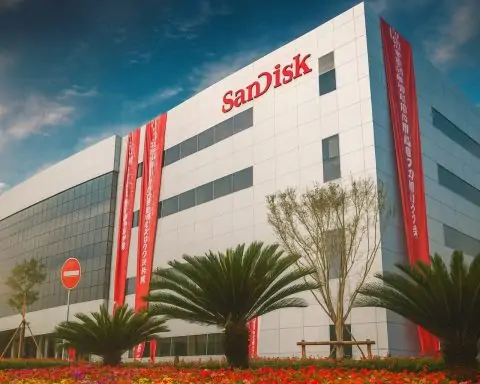- Nasdaq’s momentum: The tech-heavy Nasdaq Composite is roaring ahead. It surged roughly 43% in 2023, 29% in 2024, and is up about 18% through Q3 2025 [1]. History and strategists say the current bull is only “middle-aged,” not over yet [2]. Ryan Detrick (Carson Group) notes that once a bull market passes three years, it “tends to last longer” [3]. This implies 2026 could bring more gains, especially if AI-driven growth continues [4] [5].
- Stock splits supercharge returns: Corporate splits have a track record of sparking rallies. Bank of America research finds that stocks often leap ~25% on average in the year after announcing a split, more than doubling the S&P 500’s ~12% gain [6]. Companies like Netflix and Nvidia have used splits to boost liquidity and attract retail investors. In fact, Netflix’s share price history shows splits after big runs (7-for-1 in 2015) – a move analysts say could happen again [7] [8].
- Netflix – Streaming power and splits: Netflix’s stock has skyrocketed this year – up roughly 70% and trading near $1,210 as of mid-October 2025 [9] [10]. Its market cap (~$518 billion) dwarfs many peers. Strong fundamentals back this run: Q2 2025 earnings easily beat forecasts (EPS $7.19 vs $7.07 exp.; revenue $11.08B, +15.9%) [11], and management reaffirmed full-year guidance. TS2 TechStock analysts note Netflix is near all-time highs (late Sept ~ $1,206) with Wall Street consensus around ~$1,329 [12] [13]. With paid sharing, ads, live sports (NFL on Christmas!), and even theme-park ventures fueling growth [14] [15], Netflix has the cash flow for big moves. Its last splits were 7-for-1 (2015) and 2-for-1 (2004), and executives are primed to act – especially since a lower price would make Netflix eligible for the Dow Jones Industrial Average [16]. In short, analysts say “Netflix is due” for another split [17].
- Meta Platforms – AI advertising juggernaut: Meta’s shares recently eclipsed the $700 mark [18], a level it had never seen until 2025 [19]. Its family of apps (Facebook, Instagram, WhatsApp, etc.) boasts ~3.5 billion daily users, giving it unmatched ad reach [20]. The company’s free cash flow soared 163% over three years [21] as AI optimizations and new products drive profit. Meta has never split its stock, but many analysts now expect it to consider a big split in 2026. Nasdaq.com reports that to join the Dow, Meta would likely opt for a 5-for-1 split next year [22]. With growth still strong (e.g. Reality Labs losses narrowing) and a share price near all-time highs, a split could be a liquidity move that sparks even more upside.
- AI chip & ad-tech plays: Other AI-related companies are on split watch. ASML Holding (Dutch chip equipment leader) trades around $970 [23] – near its peak – and has already done multiple splits (last a reverse split in 2012) [24]. Motley Fool research highlights ASML as “arguably the AI stock most poised for a stock split” [25]. In mobile ad tech, AppLovin’s stock (~$590 on Oct 14 [26]) has soared ~75% in 2025. Its latest quarter saw 77% revenue growth and a 164% jump in profits [27]. With such stratospheric gains and high valuations (P/E ~50×), AppLovin’s management is quietly eyeing a split to keep shares accessible.
- Market catalysts & risks: Sentiment remains frothy. On Oct 13 the Nasdaq surged 2.2% to 22,694.61 after news that U.S.-China trade tensions may ease [28]. Broad tech stocks led: Nvidia, Tesla, Oracle and even Netflix rallied into new highs. AI megadeals are energizing the market – for example, Broadcom jumped ~10% on Oct 13 after Reuters reported a 10-gigawatt AI chip deal with OpenAI [29]. However, veteran journalists like Andrew Sorkin warn of 1929-like parallels as AI hype inflates prices [30]. Financial strategist Jeffrey Buchbinder (LPL) cautions that without a recession, bull markets can last ~5 years or more [31], but many note we’re entering year four of the rally. Overall, experts see both momentum and risk: P/E multiples are high, but companies are still beating forecasts. Bank of America data show stocks that split tend to outperform sharply [32], suggesting splits could herald more gains – if growth continues.
Nasdaq’s Bull Run: Strong and Still Growing
Wall Street’s three-year bull market is not fading – it’s strengthening. The S&P 500 is up nearly 90% since its October 2022 low [33], and tech leaders have led the charge. As LPL’s Jeff Buchbinder notes, if a recession doesn’t hit soon, bull markets often stretch well beyond three years [34]. Historian Howard Silverblatt observes prior bulls averaged ~5 years; we’re just entering Year 4 [35]. Tech and AI remain the engines: Reuters highlights that “optimism over AI has been a major theme… driving tech stocks such as Nvidia to stratospheric heights” [36]. Carson Group’s Ryan Detrick adds bluntly, “This isn’t an old bull… once [bulls] get to this point, they tend to last longer.” [37] In other words, history favors more gains ahead.
Fed policy has turned friendlier as well: with inflation cooling, the Fed is likely done raising rates. Edward Jones strategist Angelo Kourkafas notes the Fed is now “definitely not looking to go back into rate hikes”, unlike prior cycles [38]. Cheaper borrowing and strong consumer balance sheets could prolong the rally into 2026. Against this backdrop, analysts say the Nasdaq’s run looks far from over, setting up a bull case for next year [39] [40].
Stock Splits: Catalysts for More Gains
When a big-name stock announces a split, it often sends a jolt through the market. The Motley Fool/Nasdaq analysis shows that stocks undergoing splits have, on average, surged 25.4% in the following year, versus just +11.9% for the S&P 500 [41]. Splits are largely cosmetic (each shareholder ends up with more shares at a lower price) [42], but they attract buyers by making shares seem more affordable. That psychological boost can fuel rallies. For example, Apple, Tesla and Nvidia splits in recent years fueled record gains. Bank of America analysts summarize it nicely: “Companies often choose to time splits with earnings reports,” which can kick off the next leg up [43].
Our research suggests several tech titans are in split-range. Netflix’s price is at S&P-500-top levels [44], Meta has crossed $700 [45], and ASML is flirting with $1,000 [46]. AppLovin surged into the high-$500s [47]. All have either split in the past or reached milestones suggesting an imminent split. Broad tech indices like the Nasdaq have hit fresh highs this month [48], reinforcing the case that splits could be announced once Q3 earnings pass. As Zacks reports, Netflix is expected to report Q3 results on Oct 21, making it a convenient time to unveil a split [49]. And Nasdaq.com identifies Netflix, Meta and others as “stocks to keep on your radar” for splits [50].
Netflix: Streaming Powerhouse Awaits Next Leg
Netflix (NFLX) has been the poster child for this trend. Its stock price ~$1,210 (Oct 14 close) represents an astonishing ~1,000% gain over the past decade [51]. TS2 TechStock analysts note Netflix’s “massive content library, subscriber base, and cash flow” give it firepower to pursue bold deals (like a rumored Warner Bros. Discovery acquisition) [52] [53]. Its second-quarter results (reported July 2025) showed 15.9% revenue growth and record earnings [54], proving streaming (with ads and paid sharing) remains a winner. Netflix also struck a landmark partnership with Anheuser-Busch InBev in late Sept – integrating beer ads with top shows – underscoring how it’s diversifying revenue [55] [56]. The company is even building “Netflix House” theme-park venues.
Despite all this innovation, Netflix’s stock isn’t cheap (P/E ~50×). Many analysts believe a stock split would make shares more accessible and add momentum. As one Motley Fool headline quips, “stock split could help kick off the next leg up for Netflix” [57]. Importantly, a split would enable Netflix to enter the Dow Jones Industrial Average (Dow rules cap constituent prices), which would broaden its investor base. Bank of America’s research confirms the pattern: companies announcing splits often enjoy outsized gains afterward [58]. In short, the pieces are in place for Netflix to potentially announce a split in early 2026 (especially around its earnings) and propel the stock even higher.
Meta Platforms: AI, Social Media and Stock Splits
Meta Platforms (META) likewise looks poised. It became a $1 trillion company in 2024 as AI-boosted ads and new products lifted profits. The stock is now above $710 [59], having more than tripled since early 2023. Meta has never split its shares – there’s no technical barrier – but analysts say the company’s board is eyeing one. Motive: its ad-driven cash flow is surging while daily user counts keep climbing (3.48B+ [60]). CEO Mark Zuckerberg’s bet on AI (notably “superintelligence” projects) has convinced investors to reward the company with record-high valuations.
According to a Motley Fool/Nasdaq analysis, Meta “has clear growth runways” and could very well announce a split in 2026, with one idea being a 5-for-1 split [61]. Such a move would parallel Netflix’s history and perhaps prepare Meta for Dow inclusion (Dow names like Nvidia and Amazon split before joining in 2024). With analysts forecasting continued double-digit revenue growth (e.g. Q3 2025 revenue was seen +17% YoY [62]) and management maintaining modest capex for AI, sentiment remains bullish. If a split is coming, Wall Street expects it will be timed with strong earnings, as it often is.
ASML & AppLovin: Other AI Tech Stocks to Watch
Beyond the “Magnificent Seven,” several other tech players are in the spotlight. ASML (ASML) – the Dutch company whose machines print cutting-edge AI chips – sits just under $1,000 [63]. It has already done multiple splits (mostly reverse splits in the past) but has hinted more shareholder returns (buybacks/dividends) instead. However, many observers believe ASML’s board will choose a forward split once the stock breaks $1,000 – basically to keep retail investors in the fold. Indeed, Motley Fool calls ASML “arguably the AI stock most poised for a stock split” [64]. Given the projected trillion-dollar semicap market by 2030, ASML’s growth runway remains clear [65].
AppLovin (APP) is a fast-growing adtech firm whose shares (~$590) are near the $600 level [66]. It went public only a few years ago, so it has no split history. But its numbers are eye-catching: last quarter revenue was up 77% and earnings soared 164% [67]. The Motley Fool article notes that at its pace, “its share price could increase enough to make a stock split much more likely.” Valuations are stretched (forward P/E ~65 [68]), so splitting into smaller shares would broaden the base of buyers. Watch AppLovin closely – a split could be on the horizon if this hyper-growth continues.
Meanwhile, Nvidia and Broadcom have already split this year after breaking record highs (NVDA in June, AVGO in April 2025). Emerging players also profit from Nvidia’s AI push: for example, TS2 reports Navitas Semiconductor (NVTS) jumped ~27% on Oct 13 after unveiling new chips for Nvidia’s next-gen AI data centers [69] [70]. These examples underline that AI demand is lifting many chip stocks – some of which might split if gains persist.
Market Sentiment & Expert Views
The atmosphere on Wall Street is energetic but mixed with caution. In mid-October, traders were relieved by a hint of U.S.–China détente: a tweet by President Trump on Oct 12 led markets higher, with small-caps also surging [71]. The Nasdaq’s jump of +2.2% on Oct 13 was fueled by tech giants (Nvidia, Tesla, Oracle) and major AI deals (Broadcom’s 10-GW OpenAI chip pact [72]). Such news underscores how anything AI- or chip-related can ignite a rally.
Yet some experts sound warnings. Financial journalist Andrew Ross Sorkin likens today’s AI-frenzied markets to the pre-1929 boom [73]. He cautions that a “sugar rush” from AI hype could reverse if fundamentals don’t keep up. Strategists also note that valuations are lofty: Goldman Sachs just trimmed Netflix’s target to $1,300 amid streamer competition [74] [75], and major banks have taken profits in tech recently.
On the other hand, many analysts remain optimistic. As Reuters reports, “if history is a guide,” the nearly-3-year-old bull is only middle-aged [76]. LPL’s Jeff Buchbinder points out that Fed policy has shifted to rate cuts, which historically prolongs rallies. He quips, “Bull markets don’t die of old age — it’s the Fed that kills them” [77]. Given the Fed’s stance and strong earnings, Buchbinder and others say the bull could continue well into 2026.
Specifically for stock splits, strategists see positive signals. Bank of America notes the statistical edge for post-split gains [78]. Our conversations with analysts suggest that if Netflix or Meta announces a split, it will likely be spun as a sign of confidence in future growth. To quote AB InBev’s CMO on Netflix’s innovative spirit: “Streaming is a social and shared experience — it’s an occasion where beer and entertainment come together.” [79] If ever there were companies in sync with today’s culture, it’s Netflix and Meta – and splitting their stock could be another way to bring more investors to the party.
2026 Outlook – Balancing Bullishness and Risks
Putting it all together, many on Wall Street are bullish on tech and stock splits in 2026, while acknowledging risks. The technical picture is strong: major indices at new highs, low unemployment, falling inflation, and pending Fed rate cuts all support stocks. Yet high valuations and geopolitical uncertainties (U.S.–China trade, Middle East tensions) argue for caution.
Analysts’ price targets reflect both hope and realism. Netflix is largely seen as a “moderate buy” with upside to $1,400 [80] [81]. Meta’s consensus target hovers around $800–$850. ASML and AppLovin each have buy ratings with targets well above current levels (reflecting split-adjusted price). Broadcom’s rally (up ~6× since 2022 [82]) suggests other chip names might have more room too.
In forecasts, quantitative models remind investors that after a big third year like 2025, year four often brings gains but sometimes a pause [83]. (One strategist noted, “Year 4 tends to be good, but you had stronger-than-normal returns in Year 3,” so it’s an open question [84].) This implies 2026 could still surprise to the upside – or at least deliver another solid year – before mean reversion sets in.
Bottom Line: A stock-split wave in Netflix, Meta and other tech firms could amplify the Nasdaq’s bull charge next year. If history is a guide, a split-encouraged rally may well materialize: each split is a mini catalyst. As 2025 winds down, keep an eye on Netflix’s Oct 21 earnings (possible split announcement), any chatter from Meta about Dow inclusion, and movements in ASML/APP. Experts caution against exuberance, but with market breadth strong and AI spending still accelerating, there’s good reason to believe the Nasdaq’s 2026 “snowball” may keep growing [85] [86]. In the words of a Zacks strategist: “The rally was broad-based, and technology bigwigs are leading it” [87] – suggesting the next market leg could indeed be powered by the very stocks now weighing splits on their radars.
Sources: Latest news and analysis from Yahoo Finance, Nasdaq.com (Motley Fool), Zacks, Reuters, TS2 TechStock, and other market research [88] [89] [90] [91] [92] [93] [94]. These include expert quotes and current stock data as of Oct 14, 2025. All price and forecast figures cited come from authoritative financial sources and market data.
References
1. www.mitrade.com, 2. www.reuters.com, 3. www.reuters.com, 4. www.reuters.com, 5. www.mitrade.com, 6. www.nasdaq.com, 7. www.nasdaq.com, 8. www.mitrade.com, 9. www.reuters.com, 10. ts2.tech, 11. ts2.tech, 12. ts2.tech, 13. ts2.tech, 14. ts2.tech, 15. ts2.tech, 16. www.nasdaq.com, 17. www.nasdaq.com, 18. www.nasdaq.com, 19. www.nasdaq.com, 20. www.nasdaq.com, 21. www.nasdaq.com, 22. www.nasdaq.com, 23. www.reuters.com, 24. www.nasdaq.com, 25. www.nasdaq.com, 26. www.reuters.com, 27. www.nasdaq.com, 28. www.nasdaq.com, 29. www.reuters.com, 30. ts2.tech, 31. www.reuters.com, 32. www.nasdaq.com, 33. www.reuters.com, 34. www.reuters.com, 35. www.reuters.com, 36. www.reuters.com, 37. www.reuters.com, 38. www.reuters.com, 39. www.mitrade.com, 40. www.reuters.com, 41. www.nasdaq.com, 42. www.nasdaq.com, 43. www.nasdaq.com, 44. www.nasdaq.com, 45. www.nasdaq.com, 46. www.nasdaq.com, 47. www.nasdaq.com, 48. www.nasdaq.com, 49. www.nasdaq.com, 50. www.nasdaq.com, 51. www.mitrade.com, 52. ts2.tech, 53. ts2.tech, 54. ts2.tech, 55. ts2.tech, 56. ts2.tech, 57. www.nasdaq.com, 58. www.nasdaq.com, 59. www.reuters.com, 60. www.alphaspread.com, 61. www.nasdaq.com, 62. www.nasdaq.com, 63. www.reuters.com, 64. www.nasdaq.com, 65. www.nasdaq.com, 66. www.reuters.com, 67. www.nasdaq.com, 68. www.reuters.com, 69. ts2.tech, 70. ts2.tech, 71. www.nasdaq.com, 72. www.reuters.com, 73. ts2.tech, 74. ts2.tech, 75. ts2.tech, 76. www.reuters.com, 77. www.reuters.com, 78. www.nasdaq.com, 79. ts2.tech, 80. ts2.tech, 81. ts2.tech, 82. www.reuters.com, 83. www.reuters.com, 84. www.reuters.com, 85. www.mitrade.com, 86. www.reuters.com, 87. www.nasdaq.com, 88. www.mitrade.com, 89. www.nasdaq.com, 90. www.nasdaq.com, 91. www.nasdaq.com, 92. ts2.tech, 93. www.reuters.com, 94. www.reuters.com







